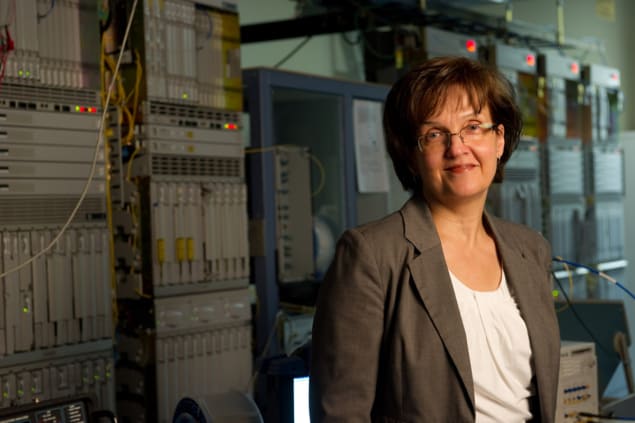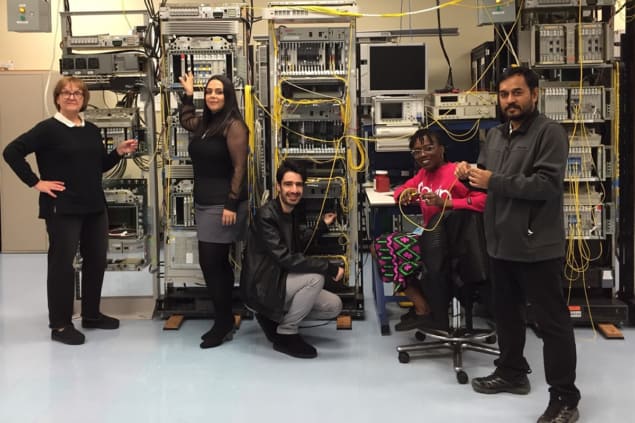Using physics to fuel fibre-optic innovation
07 Jun 2022
Taken from the June 2022 issue of Physics World. Members of the Institute of Physics can enjoy the full issue via the Physics World app.
 |
Engineering physicist Christine Tremblay talks to Joe McEntee about the joys of a career spent making fibre-optic networks cheaper, smarter and more resilient, opening the way for telecommunications firms to send voice, data and video streams down hair-thin strands of glass at ever-increasing bit rates
For a few early-career scientists, the future is a preordained pathway written in the stars; for others, it seems, the future is just as likely to be found on the back of a grocery-store receipt. Take Christine Tremblay who, in the early 1980s, had just completed the first year of an undergraduate degree in engineering physics at Université Laval, Quebec City, and was all set for a summer job at the Canadian Post Office. It was then that she bumped into one of her lecturers in the local supermarket.
Upon learning of her plans, Tremblay’s would-be careers counsellor scribbled down an alternative option on the back of his till receipt, providing contact details for two professors likely to be in need of a research assistant over the summer break. Curiosity piqued, Tremblay went to the physics department, knocked on some doors and landed a three-month placement within Laval’s Centre for Optics, Photonics and Lasers (COPL).
While there, she worked on a prototype laser-based fingerprint detection set-up and rebuilt a rather sorry-looking – in fact, totally dismantled – CO2 laser system. “I loved that summer – the atmosphere in the department was amazing,” Tremblay recalls. “I was very much the new kid in town, working alongside all these talented graduate students, but I have a can-do mindset and was eager to learn from all of them.”
Tremblay never looked back. Her engineering physics degree was followed by a Master’s degree in integrated optics and a PhD in optoelectronics, after which she spent 14 years accumulating domain knowledge and applied know-how at Canada’s leading fibre-optic technology companies. These included INO (a private research centre that focuses on optics and photonics innovation for industry partners); Nortel (at the time, one of the telecoms industry’s biggest network equipment makers); EXFO (a specialist provider of fibre-optic test and measurement gear); and Roctest (which develops fibre-optic sensors and measurement kit for geotechnical applications).
Building a hierarchy of knowledge
That granular understanding rooted in the building blocks of the fibre-optic communications network – specifically, the laser transmitters, optical amplifiers, switches, receivers and fibres that underpin high-bandwidth data transmission – has informed and enriched Tremblay’s subsequent academic research career at École de technologie supérieure (ÉTS) in Montreal over the past 18 years. “It helps you to design real-world solutions for the network when you know what the optical components can deliver and what their limitations are in terms of performance and optimization,” she explains.
For Tremblay, one big attraction of the optical communications sector is the opportunity it gives her to work with people across a wide range of disciplines, such as electrical engineers, physicists, mathematicians, component integrators, computer scientists and more recently, machine-learning specialists. There’s also lots of collaboration between academia and industry, where the focus is very much on working with equipment makers’ R&D teams (as well as marketing and business development) to translate and commercialize research breakthroughs into network-ready technologies and applications. Multidisciplinary by nature Christine Tremblay (left) and members of the ÉTS Network Technology Lab. (Courtesy: ÉTS)
Multidisciplinary by nature Christine Tremblay (left) and members of the ÉTS Network Technology Lab. (Courtesy: ÉTS)
 Multidisciplinary by nature Christine Tremblay (left) and members of the ÉTS Network Technology Lab. (Courtesy: ÉTS)
Multidisciplinary by nature Christine Tremblay (left) and members of the ÉTS Network Technology Lab. (Courtesy: ÉTS)“My R&D pathway has allowed me to work across a broad and still-evolving physics and engineering canvas,” Tremblay says. “It helps, of course, that I’m inherently curious – someone who likes to push out in new directions to pursue fresh lines of enquiry. All sorts of opportunities follow when you’re open-minded and willing to connect and collaborate with partners working on interesting problems of their own.”
That R&D focus and diversity of approach is mirrored in Tremblay’s ÉTS research group, which she says is a “multidisciplinary melting pot” comprising two postdocs, three PhD students and another 10 team members (mainly MSc/MEng students and research assistants). Significantly, given the long-term gender imbalance in telecoms engineering disciplines, Tremblay’s group has included more women than men over the last five years – and she confesses to being “very proud to have such a talented mix of applied scientists and engineers working in my team”.
Training the next generation
Beyond her broad-scope research interests, Tremblay is also passionate about professional development and education. In particular, she has done much to train the next generation of communications engineers to support the installation, testing and maintenance of high-speed optical networks – chiefly through a long-standing association with the Optical Society’s flagship Optical Fiber Communication (OFC) annual conference.
Working alongside industry colleagues, Tremblay was academic co-instructor for two well-received continuing education courses at OFC: one on optical-fibre characterization and testing in long-haul and metro-area networks; the other on polarization-related measurements in fibre networks. “These were hands-on, practical workshops targeting a mixed audience of research students, early-career engineers and senior telecoms and photonics people from all over the world,” she explains.
Crucially, all of the optical kit used by the attendees was loaned free of charge by various test and measurement companies, with Tremblay having to “wheel and deal” in advance to call in favours from the likes of her former employer EXFO. Given the interactive nature of the training, Tremblay reckons she learnt as much from the delegates as they likely took from the instructors, making some long-lasting contacts too. “I was very glad and proud to contribute to the OFC professional development programme,” she notes. “Although a non-trivial overhead on top of my ÉTS research activities, it was great fun and incredibly rewarding in equal measure.”
These days, Tremblay is a full professor in the ÉTS electrical engineering department as well as the founding researcher and head of the institute’s Network Technology Lab. This advanced fibre-optic layer testbed, developed with the telecoms equipment maker Ciena over the past decade and more, comprises 2500 km of various fibre types linking an array of high-speed optical transmission systems. Alongside Ciena, her current R&D partners are Chalmers University of Technology in Sweden, the French engineering school Télécom SudParis and Canadian telecoms service provider TELUS.
As such, Tremblay’s research programme spans several broad areas of interest. It covers, for example, “smart optical networks”, in which machine learning is used to forecast the quality of transmission in optical fibre systems, as well as the performance monitoring of installed networks (including predictive methods for degradation and failure across multiple fibre plant deployments to inform engineering upgrades). Tremblay’s group also works on “filterless” optical network architectures (based on low-cost passive optical-routing technologies) as well as photonic device modelling and polarization measurements for sensing applications in telecoms networks.
Another emerging opportunity is quantum communications. “Quantum is largely aspirational for us just now, though we are already talking to relevant experts in Canada,” says Tremblay. If funding is forthcoming, however, her team plans to optimize the performance of secure, long-distance quantum key distribution across a classical optical network using engineered quantum-entangled photonic technologies.
Research pathways aside, Tremblay’s key message for today’s early-career physicists is the same as it was 40 years ago, back in that Quebec City grocery store. “Follow your instinct and be curious,” she concludes. “It’s equally important to be alert so that when new opportunities arise, you can take advantage of them.”
Joe McEntee is a contributing editor based in South Gloucestershire, UK.
from physicsworld.com 8/6/2022
Δεν υπάρχουν σχόλια:
Δημοσίευση σχολίου